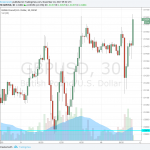After unexpectedly surging last month, the Chicago PMI unexpectedly plunged eight points to a reading of 47.6, well into contraction. Once again, economists were wildly optimistic. The Econoday Consensus estimate was 52.9. Instead, the index was lower than the lowest economist’s guess.
Highlights
Another month and another month of wild volatility for the Chicago PMI which lurched from solid expansion in January to noticeable contraction in February. At a headline 47.6, Chicago’s PMI has fallen outside Econoday’s consensus range for a third month in a row! Still, this report is closely watched and confirms other early indications of February softness, not only for manufacturing but for services as well since this report tracks both sectors. The good news in the report is that new orders have held over breakeven 50 which hints at better readings in next month’s report. Now the bad news. Production is down sharply, backlogs are in a 13th month of straight contraction, employment is down and in a fifth month of contraction, and prices paid are contracting at the fastest pace since 2009. The resilience in new orders limits the signal of damage from this report, but production and other activity look to have slowed in February following respectable strength in January.
Recent History
The Chicago PMI is expected to fall back to 52.6 from January’s great and completely unexpected 12.7-point surge to 55.6. Readings in the January report swung from yearlong lows back to yearlong highs with new orders and backlog orders posting substantial improvement along with production. Holding in the negative column, however, were employment and input prices. This report, which can be very volatile, tracks the whole of the Chicago-area economy.
Definition
The Institute For Supply Management – Chicago compiles a survey and a composite diffusion index of business conditions in the Chicago area. Since October 2011, the survey has been conducted by Market News International. Manufacturing and non-manufacturing firms both are surveyed. Hence, it is not directly comparable to pure manufacturing surveys. Readings above 50 percent indicate an expanding business sector.














Leave A Comment